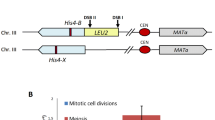Summary
Cryptic mutations are undetected base changes in genetic DNA (or hereditary RNA). Some kinds of base change are normally undetected; others may or may not be detected, depending on experimental conditions, procedures and genotypes. Cryptic mutations could affect gene conversion results because when heterozygous they cause mismatched base pairs in hybrid DNA in the same way as known mutations, but the experimenter is unaware of them. Cryptic heterozygosity will usually be much more frequent in heterothallic than homothallic organisms. The effects of cryptic mutation heterozygosity on recombination and conversion of known mutations are predicted with reference to co-conversion, map expansion and polarity. Relevant evidence is considered.
Similar content being viewed by others
References
Angel, T. M., Austin, B., Catcheside, D. G.: Regulation of recombination at thehis-3 locus inNeurospora crassa. Aust. J. biol. Sci.23, 1229–1240 (1970)
Cameron, H. R., Hsu, K. S., Perkins, D. D.: Crossing over frequencies following inbreeding inNeurospora. Genetica37, 1–6 (1966)
De Vries, H.: Die Mutationstheorie, (English translation: The mutation theory; 2 vols. London: Kegan Paul, Trench, Trübner & Co., 1910, 1911) 1901
Drake, J. W.: Heteroduplex heterozygotes in bacteriophageT4 involving mutations of various dimensions. Proc. nat. Acad. Sci. (Wash.)55, 506–512 (1966)
Emerson, S., Yu-Sun, C. C. C.: Gene conversion in the Pasadena strain ofAscobolus immersus. Genetics55, 39–47 (1967)
Fincham, J. R. S., Holliday, R.: An explanation of fine structure map expansion in terms of excision repair. Molec. gen. Genet.109, 302–322 (1970)
Fogel, S., Hurst, D. D., Mortimer, R. K.: Gene conversion in unselected tetrads from multipoint crosses. Stadler Symposia, 1 and 2, p. 89–110 (1971)
Fogel, S., Mortimer, R. K.: Fidelity of meiotic gene conversion in yeast. Molec. gen. Genet.109, 177–185 (1970)
Frost, L. C.: Heterogeneity in recombination frequencies inNeurospora crassa. Genet. Res.2, 43–62 (1961)
Girard, J., Rossignol, J.-L.: The suppression of gene conversion and intragenic crossing over inAscobolus immersus: evidence for modifiers acting in the heterozygous state. Genetics76, 221–243 (1974)
Harris, H.: Common and rare alleles. Sci. Progr.61, 495–514 (1974)
Holliday, R.: A mechanism for gene conversion in fungi. Genet. Res.5, 282–304 (1964)
Katz, E. R., Brenner, S.: Intracodon recombination in theT4 rII gene. Genetics61, s30 (1969)
Kimura, M.: Genetic variability maintained in a finite population due to mutational production of neutral and nearly neutral isoalleles. Genet. Res.11, 247–269 (1968)
Kimura, M.: The number of heterozygous nucleotide sites maintained in a finite population due to steady flux of mutations. Genetics61, 893–903 (1969)
Kitani, Y., Olive, L. S.: Genetics ofSordaria fimicola. VI. Gene conversion at theg locus in mutant x wild type crosses. Genetics57, 767–782 (1967)
Kitani, Y., Olive, L. S.: Genetics ofSordaria fimicola. VII. Gene conversion at theG locus in interallelic crosses. Genetics62, 23–66 (1969)
Lamb, B. C.: Mutations, base-changes and gene conversion. Heredity31, 137 (1973)
Leblon, G.: Mechanism of gene conversion inAscobolus immersus. I. Existence of a correlation between the origin of mutants induced by different mutagens and their conversion spectrum. Molec. gen. Genet.115, 36–48 (1972)
Leblon, G., Rossignol, J.-L.: Mechanism of gene conversion inAscobolus immersus. III. The interaction of heteroalleles in the conversion process. Molec. gen. Genet.122, 165–182 (1973)
Lissouba, P., Mousseau, J., Rizet, G., Rossignol, J.-L.: Fine structure of genes inAscobolus immersus. Advanc. Genet.11, 343–380 (1962)
Norkin, L. C.: Marker-specific effects in genetic recombination. J. molec. Biol.51, 633–655 (1970)
Rees, H.: Genotypic control of chromosome behaviour in rye. I. Inbred lines. Heredity9, 93–116 (1955a)
Rees, H.: Heterosis in chromosome behaviour. Proc. roy. Soc. B144, 150–159 (1955b)
Simchen, G., Connolly, V.: Changes in recombination frequency following inbreeding inSchizophyllum. Genetics58, 319–326 (1968)
Sobell, H. M.: Symmetry in protein-nucleic acid interaction and its genetic significance. Advanc. Genet.17, 411–490 (1973)
Sonneborn, T. M.: Degeneracy of the genetic code: Extent, nature, and genetic implications. In: Evolving genes and proteins, p. 377–397, ed. by Bryson, V. and Vogel, H. J. New York: Academic Press 1965
Stadler, D. R., Kariya, B.: Intragenic recombination at themtr locus ofNeurospora with segregation at an unselected site. Genetics63, 291–316 (1969)
Stadler, D. R., Towe, A. M.: Genetic factors influencing crossing-over frequencies inNeurospora. Genetics47, 839–846 (1962)
Thomas, C. A.: Recombination of DNA molecules. Progr. nuc. Acid Res. molec. Biol.5, 315–337 (1966)
Whitehouse, H. L. K.: A theory of crossing-over by means of hybrid deoxyribonucleic acid. Nature (Lond.)199, 1034–1043 (1963)
Whitehouse, H. L. K., Hastings, P. J.: The analysis of genetic recombination on the polaron hybrid DNA model. Genet. Res.6, 27–92 (1965)
Author information
Authors and Affiliations
Additional information
Communicated by B. A. Bridges
Rights and permissions
About this article
Cite this article
Lamb, B.C. Cryptic mutations: Their predicted biochemical basis, frequencies and effects on gene conversion. Molec. Gen. Genet. 137, 305–314 (1975). https://doi.org/10.1007/BF00703256
Received:
Issue Date:
DOI: https://doi.org/10.1007/BF00703256




